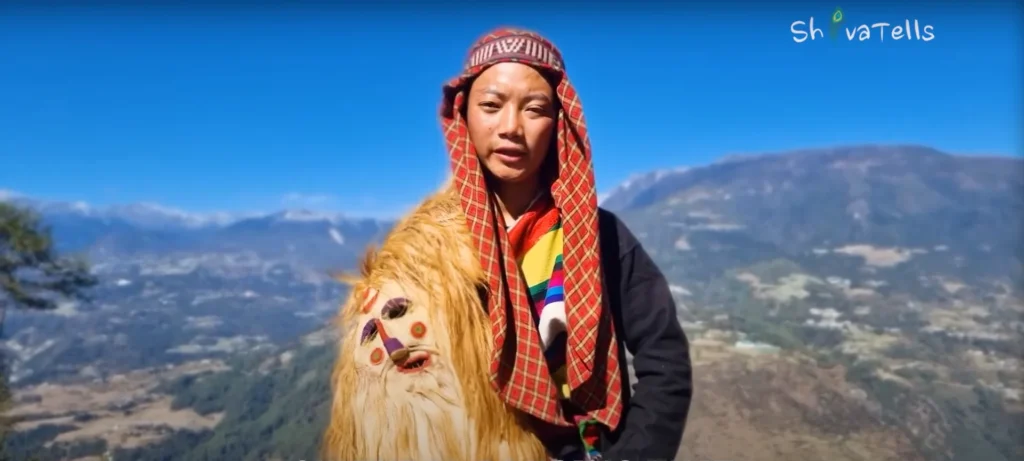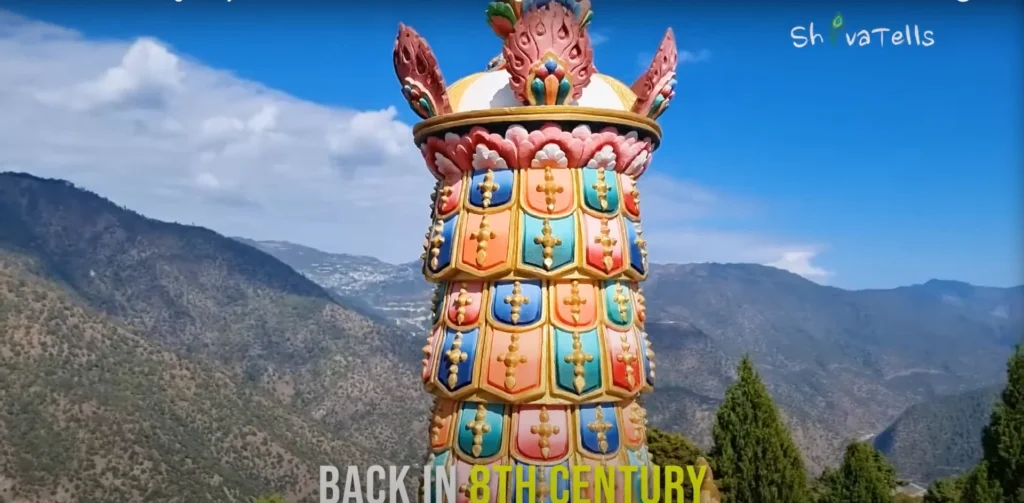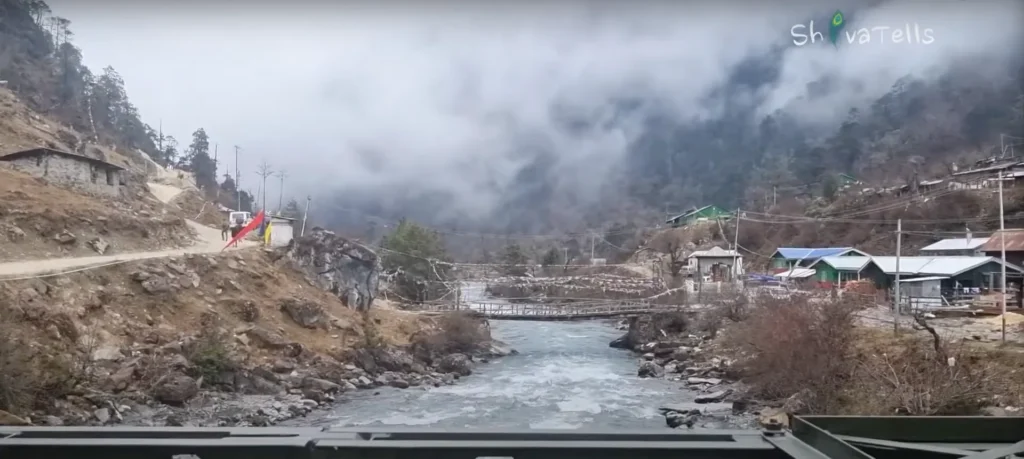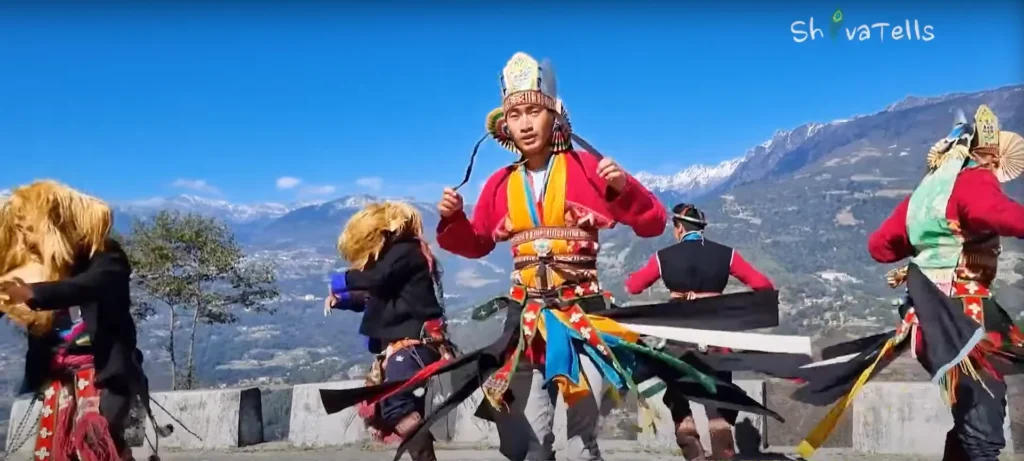Introduction to Aji Lamu
Hey guys! It’s Shiva here from ShivaTells, and today I’m taking you on a journey to a hidden gem in Arunachal Pradesh—Mukto Village. Imagine the Himalayas in the eighth century—massive, wild, and nearly impossible to cross. Back then, connecting distant villages in Arunachal Pradesh was a huge challenge. Traditional methods of building bridges just weren’t enough. This is where the Aji Lamu dance, born in the village of Mukto, came to life.
A Buddhist Chakzam Wangpo lama created Aji Lamu not just as a dance, but as a solution. It was about more than entertainment—it symbolized the connection between people, places, and ideas. The dance became a way to bring unity and hope, both physically and spiritually. Today, it is a symbol of tradition and pride for the Monpa Tribe.

Table of Contents
The Monpa Tribe

The Monpa Tribe, indigenous to Arunachal Pradesh, especially around Tawang, is known for its deep-rooted Buddhist beliefs and rich cultural heritage. The Monpas have preserved their traditions for centuries, with Aji Lamu being one of their most cherished cultural practices. This tribe lives in close harmony with nature, and their rituals, festivals, and dances, like Aji Lamu, are an essential part of their identity.
The Monpas believe that Aji Lamu not only serves as entertainment but also as a medium to connect with their ancestors and the divine. Their dedication to maintaining this dance speaks volumes about their unwavering commitment to their cultural roots.
The Origins of Aji Lamu

The story of Aji Lamu is deeply connected to the Monpa Tribe’s history. In those days, building bridges across the tough Himalayan terrain was a daunting task. But the lama saw beyond the physical limitations. He created Aji Lamu, a dance that represented ideas and innovation.
There’s a belief that the 108 man-made iron bridges scattered across this region came from the inspiration of Aji Lamu. These bridges, vital for connecting villages, weren’t just physical creations—they were born from the very movements of this beautiful dance.
Aji Lamu in Mukto Village

In Mukto Village, Aji Lamu is still performed during festivals, and let me tell you, it’s much more than just a performance. The dance can last up to seven days, with five main characters, each representing something special. It’s a ritual that brings the whole village together.
When I watched Aji Lamu, it was clear that it wasn’t just about the steps or the music. It was a moment where the villagers connected with each other, as well as with their history and culture. The dance felt like the heartbeat of Mukto, and I could see how much it meant to everyone involved.
The Spiritual Connection of Aji Lamu
Aji Lamu is not just a dance—it’s also a prayer. The people of Mukto believe that through this dance, they connect with their ancestors and receive blessings from the divine. Every movement in the dance has a deeper meaning. It reflects their faith, and you can feel that spiritual energy in the air when you watch it.
For the Monpa Tribe, Aji Lamu represents peace, protection, and unity. Watching this dance felt like witnessing an ancient prayer in motion.
Costumes and Instruments
One of the most captivating parts of Aji Lamu is the vibrant costumes and traditional instruments. The dancers wear colorful Monpa attire, and the air is filled with the sounds of cymbals and drums. Each character’s costume tells a part of the story, and the music sets the rhythm for the entire performance.
It’s a true feast for the senses. Every detail, from the costumes to the instruments, adds layers of meaning to the storytelling.
Aji Lamu: A Dance of Stories

Aji Lamu isn’t just a dance; it’s a way to share stories across generations. Through the dance, the Monpa Tribe tells their legends, their history, and their wisdom. I was mesmerized as I watched ancient tales of bravery, love, and overcoming challenges unfold before me.
It’s through Aji Lamu that the Monpa people keep their stories alive. The dance ensures that their rich culture will be passed down to future generations.
The Bridge-Building Symbolism of Aji Lamu
What struck me the most about Aji Lamu is its symbolism. The dance isn’t just telling a story; it is the story. It represents connection—both physically, through the inspiration for the 108 iron bridges, and emotionally, as it unites people.
Aji Lamu builds more than just physical bridges. It strengthens the bonds between villagers, preserves cultural ties, and bridges generations. Watching the dance made me realize how much it has shaped the identity and legacy of Mukto Village.
How to Visit Mukto Village
Mukto Village is located about 35 kilometers from Tawang in Arunachal Pradesh, and the journey itself is an experience. The scenic route is filled with stunning views of the mountains, valleys, and rivers. You can reach Mukto by road, either hiring a local taxi from Tawang or taking a bus that connects the surrounding areas.
While the roads are bumpy, the beauty of the landscape makes the trip worth it. The best part about traveling to Mukto is interacting with the Monpa people, who are warm and welcoming to travelers.
Stay Options in Tawang
When to Visit Mukto Village to Watch Aji Lamu
To witness Aji Lamu in all its glory, plan your visit during one of Mukto’s local festivals. The dance is typically performed during important cultural celebrations, especially in the winter months. Festivals like Losar, the Tibetan New Year, are perfect times to experience Aji Lamu, as the village comes alive with color, music, and performances.
December to February is the best period if you want to catch the Aji Lamu dance. During this time, the village is full of life, and the cold winter air adds to the magic of the performance.
Preserving Aji Lamu

In today’s fast-changing world, many folk traditions have faded, but not Aji Lamu. Mukto Village has worked hard to preserve this beautiful dance. Along with cultural groups and local authorities, the villagers are passionate about keeping Aji Lamu alive.
Their commitment is inspiring. Aji Lamu is not just a thing of the past—it’s a living tradition that still plays a vital role in the lives of the Monpa people.
Aji Lamu in Modern Times
Today, Aji Lamu is performed with the same love and passion as it was centuries ago. It has become an attraction for tourists who visit Mukto to witness the beauty of this dance. People from around the world are drawn to the unique culture of the Monpa Tribe, and Aji Lamu plays a key part in that cultural exchange.
Mukto Village has turned into a cultural hub, and Aji Lamu is at the heart of it.
Conclusion: Aji Lamu as a Cultural Treasure
Aji Lamu is more than just a dance—it’s a cultural treasure that connects the past, present, and future. As long as the people of Mukto cherish it, Aji Lamu will continue building bridges—not just between villages, but between cultures, generations, and hearts.
And isn’t that what we all need? More connections, more unity, and more stories that bring us closer together. For more stories subscribe to ShivaTells Channel.
